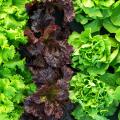Peanuts
Peanuts

Peanuts are divided into four general categories according to plant and nut types: Virginia, Runner, Spanish, and Valencia. Virginia and Runner types are mostly low-growing plants with two large seeds per pod and are the best garden types. Spanish and Valencia types are mostly erect plants, small-seeded, with the Spanish having two to three seeds, and the Valencia three to four seeds per pod.
Peanuts grow best on coarse-textured, sandy loam soils. On fine-textured soils, the Virginia and Runner types are difficult to harvest, and many pods may be left in the ground.
Peanuts are good users of residual fertilizer in the soil and may not need additional fertilizer. Soils of low fertility require about 10 pounds of 0-24-24 or equivalent per 1,000 square feet. Soils of medium fertility require about 7 pounds per 1,000 square feet. Peanuts are very sensitive to low soil pH and low levels of soil calcium.
Remove seeds that are still in the pods, being careful not to damage the seed coat or split the seed. Use one-half pound of seed per 100 feet of row. Virginia and Runner types require 3 feet between rows, with plants 3 to 4 inches apart in the row. Plant Spanish types closer together (in rows 2 feet apart with 2 to 3 inches between plants). Plant on a wide, slightly raised bed. Cover seeds with 11⁄2 to 2 inches of coarse-textured soil. On fine-textured soils, 1 inch is deep enough.
Inoculate the peanut seed where a well nodulated peanut or southern pea crop was not grown on the garden site the preceding year. Buy a fresh commercial peanut inoculant and apply it to the seed immediately before planting.
To prevent poorly developed pods, sprinkle about 21⁄2 pounds of gypsum or basic slag per 100 feet of garden row over the plants when they begin to flower.
Because peanut plants are low-growing, close cultivation is difficult. Keep weeds under control and soil free from crusts that interfere with the pegs (young undeveloped peanuts) entering the ground. Do not throw or pull soil to the plants while cultivating because this kills leaves, interferes with flowering, and increases the chance for disease.
Once pods are developing in the soil, cultivation causes injury and weeding close to the plants must be done by hand.
Peanuts are relatively tolerant to dry soils when compared to some other garden vegetables. However, they need plenty of water when flowering vigorously and when pegs are entering the soil. A water shortage at this time greatly reduces yields. Water is also important as harvest approaches. Do not water peanuts as they begin to mature. The Virginia and Runner types have good seed dormancy, but Spanish types may sprout if watered.
As peanuts mature, leaves turn yellow. Since plants flower over a period of weeks, all pods do not mature at the same time. False maturity (plants yellowing) caused by disease reduces yields. From 120 to 150 days are required from planting to maturity.
Dig when about 75 percent of the inner hulls of Spanish types and 65 percent of the inner hulls of Runner types are brown.
Dig the whole plant with a turning fork, being careful to break off as few pods as possible. Freshly dug green peanuts are excellent for boiling. After several days of exposure to good drying conditions, the moisture content of the peanuts drops from 50 percent to about 20 percent. Move plants to a warm, airy place for 2 to 3 weeks to complete curing before pulling the nuts from the plants.
Yields vary with planting date, soil pH, growing conditions, and type grown. Virginia and Runner types yield about 1 bushel (green-35 to 45 pounds; dry-15 pounds) of peanuts per 100 feet of row.
Major diseases attacking garden peanuts are leafspot, stem and pod rot, and nematodes. Control these diseases by changing the location of peanuts in the garden every year. Also, remove all dead plants and leaves from the garden site or turn them under in the fall to allow time for decomposition.
Control most leafspot diseases by regularly applying fungicides containing chlorothalonil or maneb. Sanitation is the best way to control stem and pod rot caused by southern blight.
Control velvet bean caterpillars, corn earworms, fall armyworms, and thrips with carbaryl (Sevin). Control aphids with malathion.
Publications
News
Did you know yellow squash is in the pumpkin family and are 95 percent water?
Tomatoes are a popular crop, both for commercial growers and home gardeners. Even the best tomato growers run into problems along the way! We put together a simple, easy-to-follow guide to help you spot a few of the most common tomato troubles gardeners see.
Did you know lettuce was one of the first vegetables brought to America by Christopher Columbus? What a great fun fact!




